Contents
Canadian spruce Echiniformis (Echiniformis) is one of the shortest dwarfs among conifers, and at the same time the oldest variety. History has not preserved the exact date of its appearance, but it is known that the cultivar originated in France before 1855. Obviously, the somatic mutation “witch’s broom”, which appeared on the species tree, served as the starting material for the creation of the variety.
Echiniformis has all the advantages and disadvantages of Canadian firs. It is much easier to care for than most dwarfs. This is due not so much to the greater resistance of the variety to the effects of negative factors, but to the shape of the tree itself. It makes many operations unnecessary or impossible.
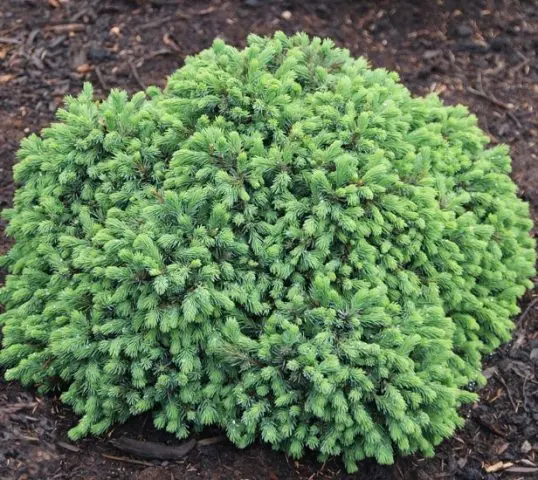
Description of Canadian spruce Echiniformis
Echiniformis is an old variety of Canadian Spruce (Picea glauca), about which it is only known that it appeared in the middle of the XNUMXth century in France, presumably from the “witch’s broom”. A young tree grows in the form of a hemisphere, and grafted onto a low stem – like a ball of the correct shape. Over time, the crown of the Canadian spruce Echiniformis spreads to the sides and becomes flattened, cushion-shaped. Unless, of course, it is not corrected by cropping.
Up to 10 years, the Echiniformis spruce adds 2-4 cm each season and reaches a height of 40 cm with a width of 60 cm. By the age of 30, the size of the tree is about 60 cm, the crown width is 100 cm. With good care, the Echiniformis spruce lives in urban conditions for 50 years .
Thin short shoots are located radially, that is, they themselves tend to maintain the shape of a ball. The crown of the Canadian spruce Echiniformis is dense, cones appear on it extremely rarely, needles 5-7 mm long are rather hard, prickly, green with a gray or bluish tinge. The root system is well developed, but spreads not in depth, but in breadth.
Canadian spruce Echiniformis often gives a reversion – a back mutation. Among the short shoots with small needles, branches of the usual size appear. They need to be cut as early as possible to preserve the variety.
Photo of Canadian spruce Echiniformis
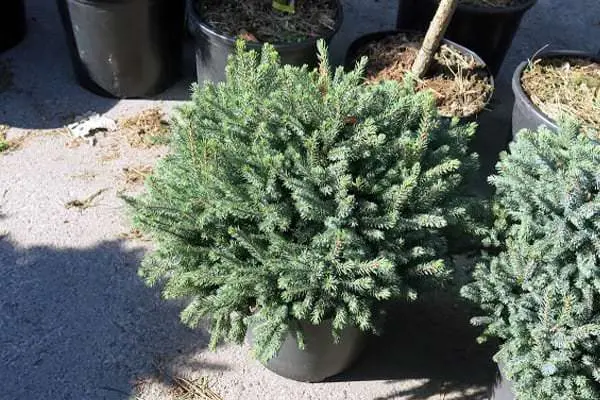
Use in landscape design
Echiniformis is an old and fairly common variety of Canadian spruce, widely used in landscape design. It is traditionally planted in rock gardens, rockeries, and other miniature conifers and heathers are considered the best neighbors.
Spruce looks good in flowerbeds and ridges framed by ground covers. In order not to block the view, Echiniformis is planted in the foreground in landscape groups and flower beds.
The plant is great for decorating slopes or a terraced area. You can place the Echiniformis Canadian spruce in containers, it looks especially impressive in low flowerpots.
What can not be done is to keep the culture as a houseplant, despite its miniature size. It is allowed to bring it indoors for several days to decorate the holiday, but no more.
Sometimes you can find recommendations to plant Echiniformis Canadian spruce as a lawn. Even if someone decides to buy enough seedlings to fill a large space, it will not look very attractive. In addition, you can not walk on such a lawn.
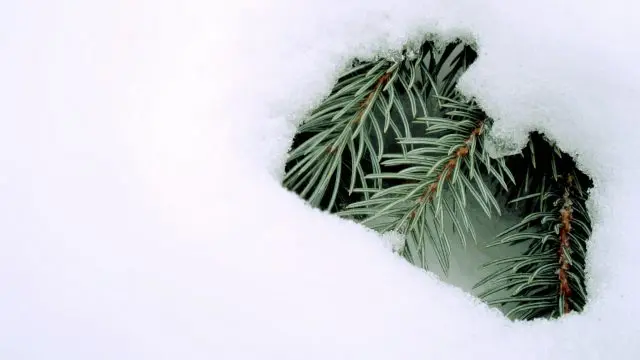
Planting and caring for Echiniformis spruce
Echiniformis is a little easier to care for than other dwarf Canadian spruces. But this does not mean that the plant can be ignored.
Seedling and planting preparation
For planting Canadian spruce Echiniformis, you can choose a flat or gentle area. You can not plant a variety in a lowland – unlike other cultivars, temporary swamping of the site will cause a loss of decorativeness, since the lower branches of the plant lie on the ground. In addition, there is a danger of rotting of the root neck. Echiniformis will feel good on an artificial elevation.
Canadian spruce will grow in partial shade or full sun. The complete absence of light causes a general oppression of the plant – it will become weak and more susceptible to infections.
The soil for planting Canadian spruce Echiniformis should be permeable, loose, acidic or slightly acidic. If the soil is not suitable for the crop, you can fix the situation by digging a large planting hole. Standard parameters – diameter is about 60 cm, depth – not less than 70 cm.
The drainage layer is made 15-20 cm and covered with sand. The mixture for planting is made up of soddy, leafy soil, high-moor peat, clay, sand. Up to 150 g of nitroammophoska is added to each planting hole. Then it is covered by 2/3 with the prepared substrate and filled with water.
Canadian Echiniformis spruces grafted onto a trunk come to Our Country for the most part from abroad, they need to be bought in containers. Domestic nurseries can put up for sale seedlings with a root system lined with burlap or jute. When buying, you should check the humidity of the earthen coma.
Spruce Echiniformis with an open root system can only be purchased in a nursery if it is dug up in the presence of the future owner. The root should be immediately wrapped with a damp cloth, or lowered into a clay mash and wrapped tightly with a film.
Close attention should be paid to the needles of the Canadian spruce. If she has an uncharacteristic color for the Echiniformis variety or red tips, the purchase should be abandoned. Such a tree, at best, has a damaged root system or is infected, at worst, it is not viable.
Rules of landing
Before planting, the pit should stand for at least two weeks. You can place a container spruce on the site at any time, except for the hot months – the tree will not take root well. But it is better to choose spring or autumn for this. If you prepare a hole in advance, in the south, Canadian spruce can be planted all winter. In the northern regions, the operation is often transferred to the spring – by the time the heat arrives, Echiniformis will have time to adapt and put up new roots.

Landing algorithm:
- First, part of the soil is removed from the pit and watered abundantly.
- The seedling is set in the center, paying attention to the position of the root collar – it should be at ground level or slightly higher.
- The pit is covered with a mixture prepared in advance. Ramming, watering.
- The soil under the Canadian spruce Echiniformis is mulched. In the spring, it is better to use pine bark for this so that the lower branches do not come into contact with the ground.
Watering and top dressing
After planting, Canadian spruce Echiniformis is watered frequently so that the soil does not dry out. But waterlogging and constant standing of moisture in the area of uXNUMXbuXNUMXbthe roots should not be allowed. Then watering is reduced. It is impossible to forget that this is a varietal tree, and not a specific spruce, and to rely on nature, even though in natural conditions only rain moistens the plant. In summer, it may be necessary to water Echiniformis every week.
Humidity is important for Canadian spruces. If the site has automatic watering, to make life easier for yourself, you can turn it on every day shortly before dawn for 5 minutes. This will successfully replace regular sprinkling. When there is no automatic watering, you need to pour the spruce crown from a hose. In the hot summer they do it every day.
Fertilize Canadian dwarf spruce Echiniformis with a specialized fertilizer. Conifers, especially those belonging to the Pine family, do not respond very well to universal top dressing – they do not have all the elements necessary for culture, and the proportions are “not the same”.
It is necessary to apply specialized fertilizers strictly following the instructions, bearing in mind that any plant is better to underfeed than to overfeed. And it is easy for such a baby as the Canadian spruce Echiniformis to give more than necessary nutrition.
Foliar top dressing is called fast, since through the needles any substances are immediately delivered to the vegetative organs. Thus, conifers perceive trace elements – they are poorly absorbed through the root. It is best to treat the crown with a solution of a chelate complex, add additional magnesium sulfate to the balloon and alternately an ampoule of zircon or epin.
Mulching and loosening
It is problematic to loosen the soil under the own-rooted Canadian spruce Echiniformis – the lower branches lie on the ground. It is easy to carry out the operation only under a grafted tree, but this must be done carefully, at a shallow depth, and only for the first 2 years after planting.
In the future, loosening is replaced by mulching. In spring, the lower branches of the Canadian spruce Echiniformis are carefully lifted and covered with pine bark. In autumn it is harvested and replaced with sour peat. At the beginning of the next season, the bark is returned to its place, it is better to buy it in garden centers, where the material is pre-treated from pests and diseases.
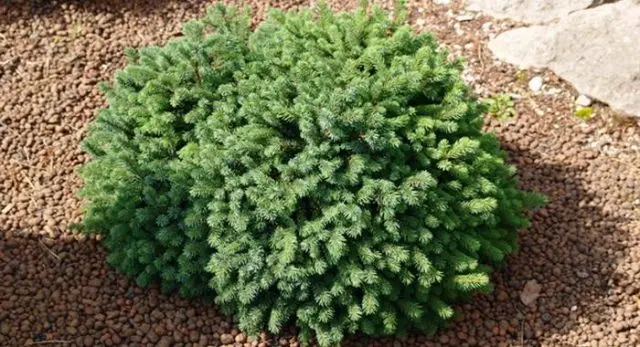
Trimming
The crown of the Canadian spruce Echiniformis is beautiful, and does not need formative pruning. But the variety is prone to reverse mutation (reversion), when a branch of a normal size for a species plant appears on a tiny tree. This is what needs to be removed as soon as possible.
If the landscape project still requires crown correction, the Echiniformis spruce can be safely cut – it tolerates it well.
Crown cleaning
The Canadian spruce Echiniformis has a dense crown due to very short internodes, because the annual growth is only a few centimeters. Without light, needles and old small branches quickly dry out and disintegrate into dust, mites often start there. Even regular sprinkling will not be able to improve the situation.
Before cleaning the Canadian Echiniformis spruce, care must be taken to protect the hands, eyes and nasopharynx. Needles cause skin irritation, and tiny dried particles of dry bark and needles, once on the mucous membrane, can even lead to swelling.
During the cleaning, the branches of the Canadian spruce are carefully parted to the sides, and dry needles and easily breaking shoots are removed with gloved hands. Then the litter is carefully collected so that nothing remains under the tree. Sometimes it takes more time than the cleaning itself.
The last stage is the treatment of the crown of the Echiniformis spruce and the soil under it with a fungicide. It is better to use a preparation containing copper for this purpose. During cleaning, no matter how carefully it is carried out, some of the branches will be injured. In order to prevent infection from getting into the wounds, the spruce is literally doused with cuproxate or Bordeaux liquid – the crown should be blue outside and inside.
Preparation for winter
The dwarf size of the Canadian spruce Echiniformis makes it possible not to care too much about its shelter for the winter, even in Siberia, the Urals and the North-West. If the tree is planted in a calm place, or covered from the prevailing winter air currents by other plants, the crown will still be under the snow.
It is only necessary to protect the Canadian spruce Echiniformis the first year after planting, in regions with cold winters with little snow, or planted in places where snow is blown. A small tree can be mulched with peat, and the crown can be covered with a cardboard box with holes made for air access. Or wrap the crown with white non-woven fabric.
In the spring, you should not forget to remove the shelter, since for coniferous crops it is more dangerous for the crown to rot than to freeze. The needles, somewhat darkened from low temperatures, usually restore turgor and color after several treatments with epin. Older branches have to be cut off completely, and a badly damaged Canadian spruce may die.
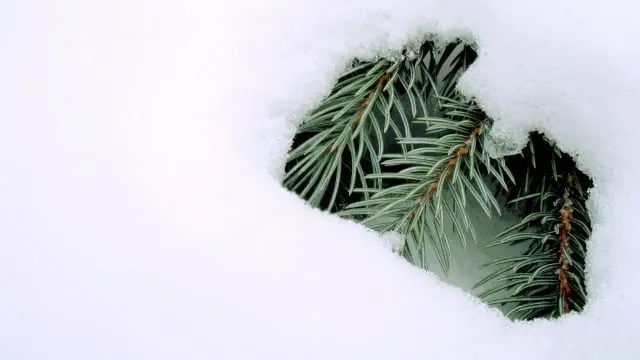
Sun protection
The Echiniformis variety suffers less from early spring burns than other Canadian spruces, especially if the winter was snowy. Damage to conifers at the beginning of the season occurs because the root is not yet able to supply moisture to the upper part of the tree, and the sun’s rays contribute to the evaporation of water from needles and branches.
The crown of the Echiniformis spruce is pressed to the ground surface. Often, simultaneously with the evaporation of moisture from the needles, snow melts, increasing the humidity of the air. But this does not always happen, and in order to be safe, it is better to cover the fir tree located in the open with a white non-woven fabric or burlap on a bright afternoon.
In the future, if you turn on automatic watering for 5 minutes every day, or carry out sprinkling in another way, there should be no problems with the Canadian Spruce Echiniformis. But the tree will respond positively to the treatment with epin.
Reproduction
Before embarking on the propagation of Echiniformis spruce, gardeners should clearly understand that this is not an easy task, even for professionals. And they have specially adapted premises and experience.
In any case, Echiniformis canadian spruce can be propagated by cuttings or grafting. Cones rarely appear on the tree, their seeds are very likely to grow into species plants. Even if some come out stunted, they will look little like the mother form.
It is better for amateurs not to mess with vaccinations, but you can try cuttings. It’s better not to hope for success anyway. Rooting shoots is only half the battle. They still need to be brought to landing on a permanent place, and this is a few more years, when any slightest mistake in care will lead to the death of the plant.
Echiniformis spruce cuttings can be taken for rooting all season, but it is easier to do this in the spring. Cut them with a piece of the bark of the older branch. It is better to take one completely, and “disassemble” into cuttings.
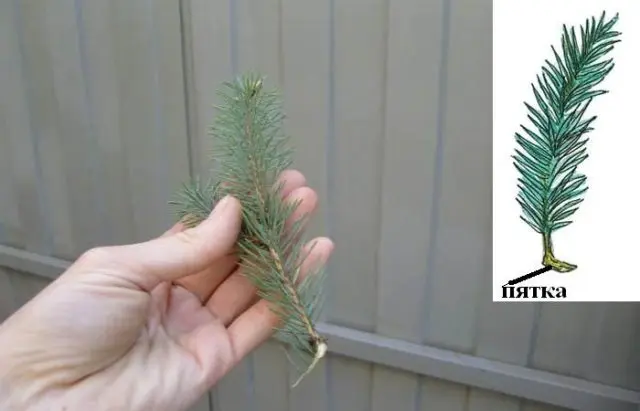
The lower part of the shoot is freed from needles, treated with a stimulant, and planted in sand, perlite or peat-sand mixture. The substrate and the air around the cuttings must be constantly moist. Those branches that have taken root and started to grow are transplanted into a more nutritious soil. Spruces are determined to a permanent place when they have lateral shoots.
In an old plant, Echiniformis, the lower branches lie on the ground, sometimes taking root on their own. The tree practically becomes a colony. But it is difficult to plant such a Canadian spruce; most often, when moving to a new place, both the rooted branches and the mother plant die. If we do this, then at the very beginning of the season in the north, and before winter in the south.
Diseases and pests of Echiniformis spruce
The description and photo of the Echiniformis spruce shows that its crown is dense and literally pressed to the ground surface. Therefore, diseases are the most dangerous for a tree. Often the variety is damaged by snow shute. In order for spruce to be healthy, it must be sprayed with copper-containing fungicides at the beginning and end of the season. At the first signs of disease, unscheduled treatment is carried out. Most often, Echiniformis is affected:
- rots;
- rust;
- necrosis;
- wound cancer.
Of the pests, the spider mite must be isolated separately. This small insect often starts inside the crown of the Canadian spruce Echiniformis, if the branches are not moved apart during treatments. Sprinkling is the best prevention. If the tick has already appeared, spraying with acaricides is effective. Insecticides destroy other pests:
- spruce sawfly and leaflet;
- hermes;
- mealybug;
- aphids;
- caterpillars of the Nun.
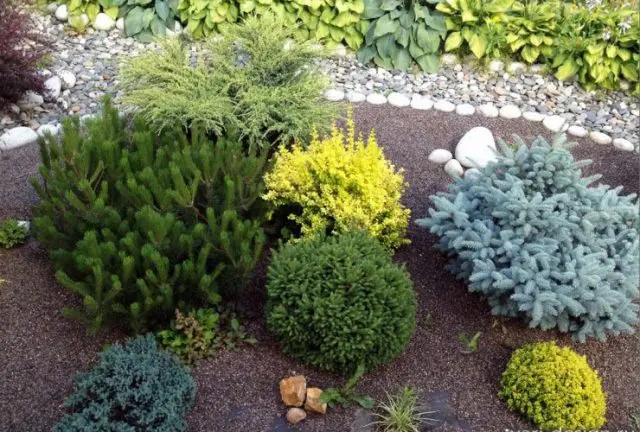
Conclusion
Canadian spruce Echiniformis is one of the shortest varieties. The tree forms a dense crown pressed to the ground, which looks beautiful framed by other conifers, heathers, flowers or stones.









